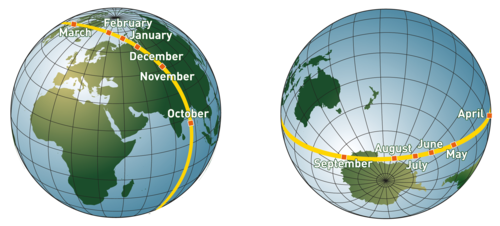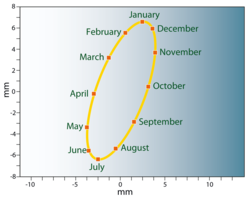Monitoring the small wobbles of our Earth's center of mass
Image of the Month - February 2020
The Earth’s surface is ever-changing: fluid mass (oceans, continental water, snow, atmosphere, ...) redistributes on the Earth's surface. The terrestrial crust is in turn deformed by these changes, which move around its geometrical center. This motion, or "geocenter motion", can be considered with respect to the center-of-mass of the Earth. Even though its amplitude is smaller than the size of a cherry, it is necessary today to take into account its perturbing effect on the modeling of ground station observations (which are installed on the crust, and thus tied to it and its motions), e.g. for in situ estimates of the sea level rise. It is also used to observe the natural orbital motion of the satellites around the center-of-mass (according to Newton's laws)...
The Doris system enables to measure such minutes motions, as can Laser and GPS. The Doris tracking network is stable and uniquely well distributed geographically. Moreover, the technique is not affected by clouds so can be used all year round, everywhere on Earth. Its presence onboard satellites such as Topex/Poseidon and the Jason missions, which are non-sunsynchronous with an unusual orbit for Earth Observation satellites, also bring a different point of view (non aliased on tides, in particular). With 30 years of Doris data now available from the very first measurement on Spot-2 (Feb. 3, 1990) long-term studies of these small reference motions can be done. They also will be possible to be continued into the next two decades.
See also:
- Doris
- Image of the Month, February 2016: Thule Doris station's rising at different velocities
- Image of the Month, October 2009: Dumont d'Urville movements measured by Doris
- Applications: Other geophysical applications
Websites on this subject:
- Presentation of Doris (Cnes)
- International Doris Service (IDS)
including interactive Tools to plot Doris locations time series
Reference:
- Couhert, A., Mercier, F., Moyard, J., & Biancale, R. (2018). Systematic error mitigation in DORIS-derived geocenter motion. Journal of Geophysical Research: Solid Earth, 123. https://doi.org/10.1029/2018JB015453






